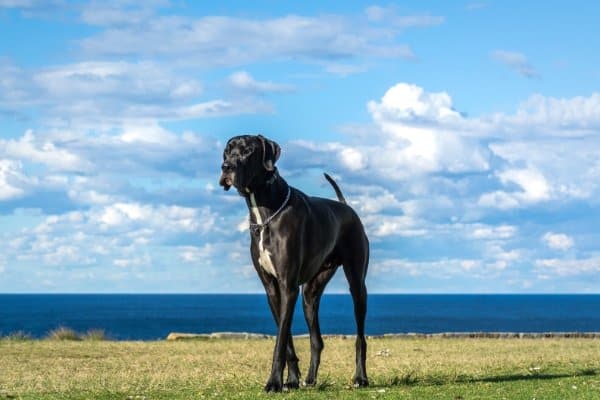In some ways, the Great Dane breed is one of contradictions. For instance, despite the name, this breed is of German descent.
Another example is that although these huge dogs have an intimidating appearance, they are lovingly referred to as “Gentle Giants” by those who know them.
You may be wondering if the color of a puppy’s coat is as deceiving as the breed’s name and appearance or if it’s an accurate indication of the eventual adult color.
Do Great Dane puppies change color? Yes. Many Great Danes will experience a slight change in color as they transition to their adult coat. Most often, the colors will become richer, darker, and deeper, though color lightening is also possible due to shedding or exposure to lots of sunshine.
Coat color changes often take unsuspecting owners by surprise.
Being aware of the possible changes in color that may occur with your growing puppy is the best way to prevent a shocking discovery later on.
Standard Great Dane Color
Before diving into the issue of color change in Great Dane puppies, we should first discuss what the acceptable colors are for the breed in general.
The American Kennel Club officially approves of the following colors: black, white, black and white, blue, brindle, fawn, harlequin, mantle, and merle.
Other colors commonly seen in Great Danes but considered to be disqualifications in the show ring include blue and white, blue brindle, chocolate, chocolate and white, chocolate brindle, mantle merle, merlequin, and silver.
Black or white markings and a black facial mask are considered perfectly acceptable, but a blue or chocolate mask is frowned upon.
Blue, brindle, chocolate, fawn, and merle markings are quite beautiful on a Great Dane, but are disqualifications for show purposes as is the piebald pattern.
When searching for a Great Dane, you’ll likely run across breeders claiming to have rare breed colors.
Sure, the colors and markings can be striking, but keep in mind three things if you’re considering purchasing a “rare Great Dane.”
- The price is often much higher, even though other traits, such as body type, might be substandard.
- With each intentional breeding for unusual colors, the breeder is taking one more step away from the breed standard that has been in place for many years with good reason.
- Those “rare” colors are often mismarks. In other words, they are not desirable in the breed.
We only mention the possibility of “rare”colors because sometimes owners new to the breed may think that their puppy’s coat is changing color when in fact, they are only just noticing that their dog’s color is not a standard one.
Now that we’ve gone over the standard, acceptable coat colors for Great Danes, let’s get back to the question at hand. Do Great Dane puppies change color?
Great Dane Puppy Color Changes
Great Dane puppies, like all dogs, are born with fur that is close in color to what their future adult coat will look like.
Notice we say close in color, not exact in color. It is quite possible that this color will change slightly as the dog matures.
Those who have worked with Great Danes for many years often recommend looking at the color present on the pup’s head, not the body, for a more accurate idea of what the adult color will one day be.
Up until the age of 1 year or so, you most likely won’t notice any significant color changes in your Great Dane.
He will remain pretty much the same as when you first brought him home – well, other than the tremendous amount of growth, of course.
Somewhere around a Great Dane’s first birthday, the process of “blowing coat” will begin. In some dogs, this may start as early as 10 months old, but the average age seems to be 1 year.
The term blowing coat may sound terrible, but it is actually a normal and necessary occurrence.
During the process, which can take as long as six months to complete, the softer, fluffier puppy fur is shed as the new, slightly stiff adult coat grows in to take its place.
You’re probably wondering what shedding has to do with color change, right?
Well, you see, it is usually during the process of blowing the puppy coat that owners first notice a change in their dog’s coat color.
Let’s see what kind of changes you might observe.
Will the Coat Darken Over Time?
A Great Dane’s adult coat is often a shade or two darker than the puppy coat was, so yes, the coat may darken as your dog matures.
This is true of all the color possibilities within the breed, but is often more pronounced in dogs of darker color.
The coat color will often transition to bright, rich, deeply saturated hues of the original puppy color.
Though many owners lament losing the soft silkiness of the puppy coat, they are usually quite pleased with the darker, richer colors that come with the adult coat.
Light colored fawns may develop a deep, yellow-gold color, which just so happens to be the most common color in the breed.
Solid black Great Danes or those with patches of black, like mantles, merles, and harlequins, will likely develop a rich, glossy, black coloration.
Don’t be surprised if a powdery blue pup gradually turns to a more steel-gray color.
You get the idea.
The adult color is usually a more enhanced version of the coloration shown as puppies.
Just so you know, spots and patches of color can change too.
For example, a harlequin may develop more patches with age, a merle’s patches may become significantly darker, and a piebald might develop ticking all over the body.
Do Great Danes Ever Become Lighter in Color?
Sometimes, instead of experiencing an all-over darkening of color, some puppies may actually become lighter.
While this change is usually only temporary, owners are often surprised because they were expecting to see deeper coloration as time passed.
Lightening of the coat’s color usually takes place due to one of two possible causes: shedding and sunshine.
Shedding
If a puppy is undergoing a heavy shed, whether it’s caused by seasonal changes, blowing the puppy coat, stress, or health conditions, for a brief time, the coat will appear lighter in color.
The change may be so dramatic that a dog with a black coat may appear chocolate or reddish-brown, and a blue Great Dane may appear brown or more gray than blue.
This apparent lightening is due to the old, dead fur still clinging to the coat.
Young Great Danes will often transition to a much lighter color before the vibrant, new adult coat replaces the old one.
Superior nutrition can help the shedding process a great deal. Owners who have switched to a premium kibble usually see an improvement in shedding.
The plethora of choices can be confusing. We have a comprehensive dog food guide if you need some advice.
Transitioning to a raw diet isn’t something to take lightly and should only be done while working closely with your vet, but many Great Dane owners have noted drastic improvements in coat health after making the switch.
It’s worth considering.
Note that rubber grooming gloves or a similar product are recommended for removing shed fur from very short-haired breeds like the Great Dane.
Exposure to Sunshine
If you spend a good deal of time outdoors in the summer, then you know that strong sunlight can lighten your hair a shade or two in just a few weeks.
The same thing can happen to your Great Dane. Long periods of exposure can cause your pup’s fur to lighten in color considerably due to the bleaching effect of the sun’s rays.
Of course, you shouldn’t expect a black dog to turn white, but deep, rich colors may become dull, and dogs who are light-colored to start with may become paler.
Colors should return to normal when the summer coat is replaced by the thicker winter coat.
Just be prepared for even more lightening during the shed until the fresh, new fur overtakes the worn-out coat!






